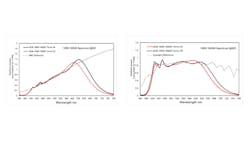Bridgelux has commercially announced the Thrive 93 series of LEDs that produce what the company calls natural light and at the same time maximizes efficacy in end products such as solid-state lighting (SSL) replacement lamps. The company is also selling a Thrive 98 product that has even better color rendering in the red region, but that offers slightly lesser efficacy. Both of the LEDs are based on dual pumps that the company first demonstrated back at LEDucation in March 2019.
We will certainly acknowledge that in the LED industry it takes quite a long time to deliver a technology to a commercial market. Moreover, vendor relationships invariably come into play. Still, the time lapse between spring of 2019 and now is significant.
After that original demonstration of Thrive, we have heard little from Bridgelux officially on the subject. In February of 2020, at Strategies in Light and the last live LED and SSL event prior to the pandemic, then LEDvance CEO Lawrence Lin offered a keynote presentation touting a new Natural series of SSL lamps that delivered a natural light spectrum. LEDvance termed the technology behind the lamps as TruWave. Lin would not reveal the vendor behind the LEDs and only said that the company sourced products from Bridgelux, Nichia, Seoul Semiconductor, and others.
In that previously mentioned coverage of LEDvance’s plans, however, we made a mistake in how we characterized the shared lineage of LEDvance and Bridgelux. It is true that MLS is now the sole owner of LEDvance. Bridgelux, meanwhile, is owned by Kaistar, and MLS has only a minority stake in Kaistar. There is no indication that a shared lineage has had any impact on potential business between the companies.
Lin, however, depicted an SPD graph at the Strategies in Light presentation that exactly appeared to be the same graph that Bridgelux had shown at its initial demonstration and that is shown again here as the blue curve titled Thrive at 3000K — with Thrive 93 mimicking what the company says is the natural light of an incandescent bulb. The SPD demonstrates the dual emitters that fill in the cyan gap and minimize blue energy overall, and that largely follows a linear line up and to the right through the human visual range aligning mostly with an incandescent SPD.
In any event, the Thrive 93 LEDs is now readily available. “The broad blue emission is what allows the Thrive family of products to match daylight so well,” says Mark van den Berg, vice president of sales at Bridgelux. “By creating multiple blue emission peaks, we are able to better replicate daylight than competitors whose LEDs emit a single, narrow spike of blue.”
Indeed, Bridgelux is marketing the Thrive 93 technology as being a good fit for lighting for health and wellbeing or human-centric lighting applications. The natural light spectrum is said to improve eye comfort, emotional wellbeing, and sleep/wake cycle.
And the point that Bridgelux is stressing in this release is that you can get good efficacy and good light quality with Thrive 93. Both Thrive 98 and 93 deliver good color rendering scores. But Thrive 93 only delivers an R9 score for saturated red rendering of 50, whereas the Thrive 98 LED delivers a score greater than 90. Bridgelux says Thrive 98 enables high CRI and sunlight-like SPD — much like some other high-CRI LEDs on the market. But Thrive 93 delivers a 12% efficacy advantage. “In Thrive 93, designers can enjoy premium fidelity across the entire spectrum in addition to amazing efficiency all in the same LED package,” said Tim Lester, CEO of Bridgelux.
Again, the natural light SPD shown in the nearby graph tells the tale. The Thrive 93 SPD does fall off more quickly in the red region than do some high-CRI lamps. This same issue was debated at that 2020 Strategies in Light keynote. Bridgelux says it conducted extensive interviews that prove Thrive 93 preferable to other high-CRI technologies.
Meanwhile, the practical side is much simpler to explain. Some high-CRI offerings in the industry result in lamps that don’t meet the highest efficacy limits of some market transformation programs. Bridgelux says Thrive 93-based lamps meet the requirements of all such programs. At the same time, Bridgelux says Thrive 98 is being widely used in the industry in applications such as commercial luminaires.
Of course it’s near impossible to follow the LED and SSL players without a good scorecard. We’d presume that Bridgelux has been supplying Thrive 93 to LEDvance going back to that aforementioned keynote or sometime shortly thereafter. But there was a recent press release in which Seoul Semiconductor said that its SunLike LEDs had now won spots in some Natural-branded SSL lamps targeted at the European market.
LEDs Magazine chief editor MAURY WRIGHT is an electronics engineer turned technology journalist, who has focused specifically on the LED & Lighting industry for the past decade.
*Updated Nov. 16, 2021 11:06 AM for company ownership clarification.
*Updated Nov. 16, 2021 12:50 PM for image replacement.
For up-to-the-minute LED and SSL updates, why not follow us on Twitter? You’ll find curated content and commentary, as well as information on industry events, webcasts, and surveys on our LinkedIn Company Page and our Facebook page.







